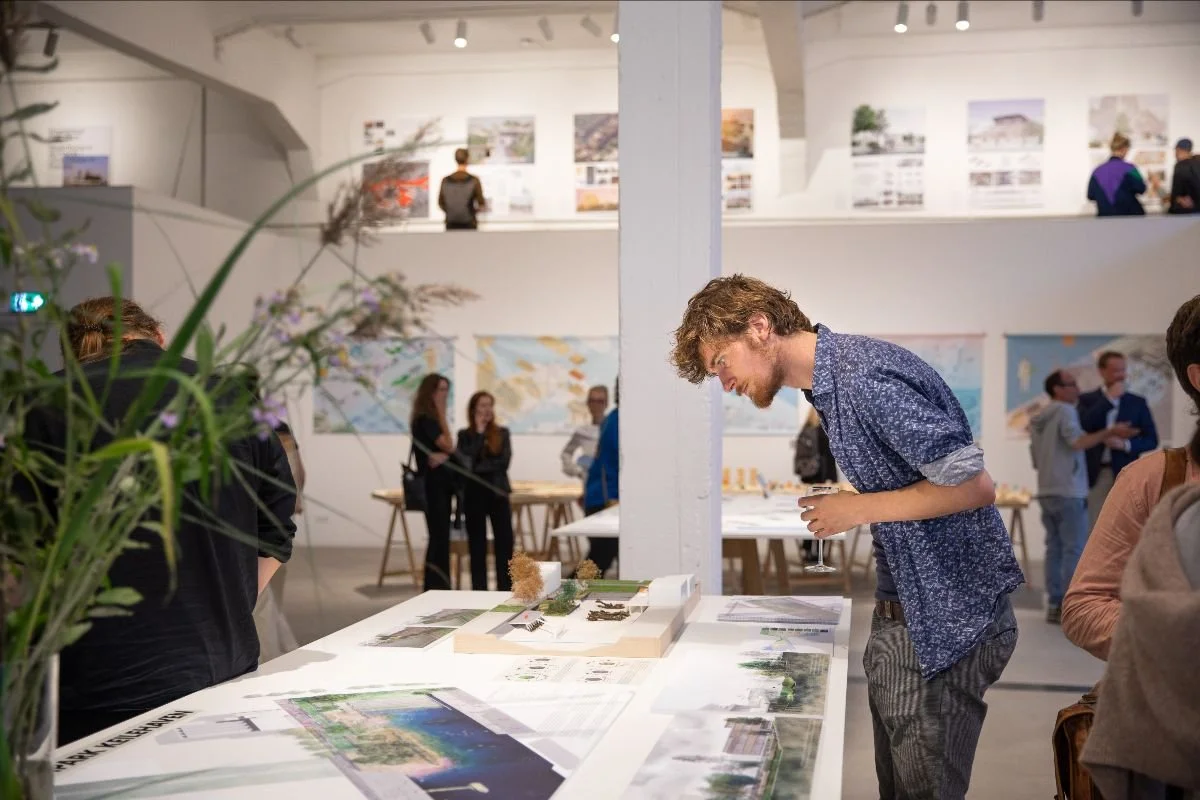Presented by the KeileCollective
HOW DO WE WANT TO BUILD M4H 2030
-
The mixed-used port area Merwe-Vierhavens (M4H) in Rotterdam is on the eve of a transition to a cultural living-working district, where circularity is central. The Keile Collective invites you to discuss the question 'How do we build future-proof at a time when there is high pressure to build homes and workspace quickly and affordably?' in the exhibition. By linking this question to the planning in M4H, the exhibition provides impetus for the realization of a climate-positive living environment from 2030; the year in which the first residential areas on the Merwe piers in M4H will be completed.
The exhibition is in line with the Spatial Framework M4H with its overarching motto: 'Collectivity as a basis for circularity'. To transform from a system focused on the individual to one of collective networks is complex and takes time. That is why the exhibition is rooted in the philosophy of Roman Krznaric's long-term thinking. This assumes 7 generations, which is approximately 200 years.
The timeline from 1900 to 2100 takes you from the past to the tipping point we are in now and looks into the future. It highlights important moments such as the Housing Act in 1901, the car-free Sunday in 1973, Groningen getting rid of gas in 2024, and the moment when the goals of the Paris Agreement must be achieved in 2050.
Looking 100 years back and 100 years ahead creates a sense of urgency, complicity and ownership. Four themes have been developed along this timeline, each zooming in on a specific aspect of the built environment: landscape, urban development, architecture and materials. In the fifth line, these themes come together in the storyline of M4H.
The research shown provides insight into the development of Dutch building culture and shows how we hope that development will continue over the next 100 years. Can we program that development? Can we dream about how we want to build?
-
Focus: Vital Soil
In this thematic line we investigate how can we built towards a climate and future-proof M4H area with attention to people, plants and animals.
We start with an imagination of the age-old tidal landscape where M4H was built around 1900. The original bottom was covered under one anthropogenic soil layer. This offered the constructive basis to build on and provided underground space to cables and pipes. We visualize 2000 therefore as a petrified city with loss of biodiversity, flooding and heat stress.
In 2024 we will demonstrate a landscape-oriented approach in which it becomes urban life, spaces and buildings stretched into a habitat for all life. In here we take the perspective of the plants, animals and fungi emphatically participate, creating a symbiotic relationship can arise. In 2100 we will investigate with a conceptual model of the Keilekwartier wat it can mean as all life as a starting point for area development is taken. What is the relationship between healthy soil and sustainability water system? Provides systemic thinking about water and soil cycles new symbiotic spatial city typologies?
-
Focus: Lifestyle
In this thematic line we investigate the relationship between urban planning, lifestyle and our ecological footprint. Does our environment determine our lifestyle?
We depict several examples of four historical and one future neighborhood typologyRotterdam. We place these in a national historical context of economic trends, policy making, political and social developments, which are shown through of a timeline.
With this we investigate the interactions between it design of the neighborhood and the lifestyle of its residents from now. We invite both urban planners and residents to reconsider choices. It goes in our pursuit of the Paris goals is solely about efficiency (do the same with less CO2)? Or we can too choose what we feel is more sustainable, friendlier or makes you more resilient.
We call this pursuit of sufficiency: embracing it of a lifestyle within planetary boundaries, true we don't have everything, but enough, and where we not exploit the systems around us but to respect. What does that mean for urban planning? What does a neighborhood look like where these choices become easy?
-
Focus: construction methodology
In this thematic line we shed light on the development of Dutch housing technology.
To this end, we have two typical residential buildings: projects analyzed; Vreewijk (1918) and Merwede (2024). By analyzing the structural cross-sections provides insight into the evolution of construction technology and the materials used. Through the materials to collect, organize and sort each other is created a comparable overview of the materials used we built and are building our homes. The result are spatial bar graphs showing the applied material per resident in both projects. The spatial diagrams provide insight into what we are doing have known for a long time; we are more material, more types material and more polluting material.
Do you see the differences? What was good in 1900? What in 2000? What will we take with us to 2100? And above all, what do we want to leave behind? Can we do 100 together? Looking ahead years? How do we want to build in 2100?
Or… is that question misleading? Because like an architect Cedric Price once put it: “There is nothing worse than answering right a wrong question”.
H̶o̶w̶ do we want to build in 2100?
-
Focus: Material Transition
In this thematic line we focus on development of material use in construction from 1900 onwards we investigate a future scenario in the context of M4H.
The way we build is the last 100 years changed drastically. Our current built environment contains an incredible number of material types and installation systems. Where do these come from? How does it work? And what is the material-related CO2 impact?
We look back to the beginning of the 20th century, then using simple, locally sourced materials built and there are hardly any installations in the buildings were included. We reflect on the day of today where materials are sourced from all over the world are extracted and industrially processed in complex composite materials that are difficult to separate can be collected or recycled. Looking ahead, we speculate about the possible future of our built environment. Do we choose to to build for eternity, or to be dismantled and portable construction? We can in the future realize buildings with much less instead of a lot more installation technology? We can with the knowledge of already pre-sort for Paris Proof and climate positive design and build in 2050?







